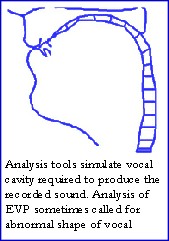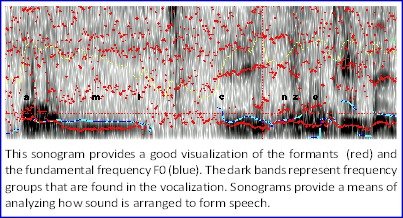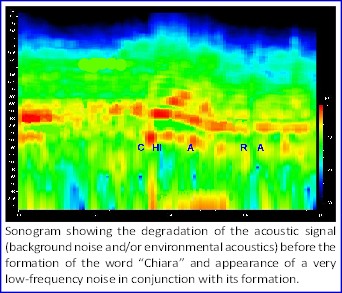“SFINGE” PROJECT”
Previously published in the Winter 2014 ATransC NewsJournal
(Digested by ATransC. See: Interdisciplinary Laboratory For Biopsychocybernetics Research [Defunct])
Abstract
The research team of Il Laboratorio from Bologna, Italy conducted a two-year long study of well-known Electronic Voice Phenomena (EVP) operator, Mrs. Lida Russo of Livorno, Italy. The microphone recording method with a commercial recorder with built-in microphone was used by the operator and professional digital devices were used to monitor the sessions. However, only a few anomalous voices of poor acoustic quality were found upon review of Mrs. Russo’s audio tape. Contrary to the expected, the most interesting voices in terms of quantity and quality were recorded on the digital devices operated by Daniele Gullà.
State-of-the art software commonly used for forensic analysis was used for analyses of the resulting voices. This new approach to EVP research was introduced to the world by the researchers of Il Laboratorio and has revealed many structural electroacoustical features that prove the authenticity of these acoustic events, which now can legitimately be classified as linguistic events.
Introduction
 The so-called “paranormal voices or Electronic Voice Phenomena ” have been studied for more than forty years and consist of recorded sounds and/or sounds directly audible through the experimentation equipment. These events can manifest spontaneously or as coherent answers to the questions of the researcher.
The so-called “paranormal voices or Electronic Voice Phenomena ” have been studied for more than forty years and consist of recorded sounds and/or sounds directly audible through the experimentation equipment. These events can manifest spontaneously or as coherent answers to the questions of the researcher.
Research Aim
This Il Laboratorio study of the anomalous voices is called “Progetto Sfinge” ( English: “Sphinx Project”). In order to understand the reason for this name it is necessary to recall the symbolic meaning attributed to the Sphinx as an unresolved mystery. The application of innovative methods of research, and availability of the latest information technologies, has made it possible to investigate the phenomenon through many different perspectives inconceivable until recent years.
Progetto Sfinge’s principal aim is to document differences in the phonic structure of the anomalous voices as compared with human voices. Where possible, the degree of similarity between a voice attributed to a dead person and the voice when the person was alive was compared. The project’s accomplishment has been possible thanks to a generous contribution of the Swedish Foundation Helene Reeder Memorial Fund.
Research Setting
There are many opinions about the nature of the phenomenon. For some, the voices lack objectivity and are the consequences of psychoacoustic illusions (psycholinguistics). Others, mostly those who had direct experience of the phenomenon, say they are strong evidence of survival.
The perception of acoustic signals as human language, and their subsequent interpretation, is the most critical moment in the understanding of speech. The first consequence of this psychic process is the possible interpretation of the signals in many different ways or, as those who study psycholinguistics define them, events of “interpretative plurality.” Many are the factors that contribute to this critical situation such as the ambiguity and fragmentation of the acoustic events or when the listener has a poor understanding of the language.
Even in normal listening conditions, the danger of psycholinguistic illusion is ever-present in the interpretation of voice. This problem is further stressed by listening to ambiguous sounds when there is the wish to “receive” messages from the other side; perhaps when the listener is under emotional stress due to the loss of a loved one (wishful thinking).
Thanks to developing professional competence and the availability of advanced information technologies, after decades of discussions in favor and against this phenomenon, we decided to undertake interdisciplinary research. This research had the purpose of documenting the existence of the anomalous voices and identifying the characteristics that make them different from human speech. For the first time, the new technology has made it possible to examine the acoustic structure of the anomalous voices to clearly define their characteristics and semantic content.
This phenomenon can no longer be considered an independent occurrence. It must be placed into a Phenomenal System1 grouping “all realities, concrete or abstract, which constitute the background of that event; in other words the elements or the parts (the variables) of physic, biological or psychological nature that are integral part of the event itself.”1
For this reason, our research also investigated the role and personality of the person who recorded the voices. The operator is, in fact, an important part of the experiment, and in the final analysis, of the phenomenon. The psychological and psychophysiological analysis of the operator was conducted by specialists in order to identify possible correlations with the resulting anomalous voices.
The experimentation was to have been accomplished through the technique of microphone recording, usually as adopted by the operator. The voices obtained with her recorder were to have constituted the collected data and the object of instrumental analysis. At the same time, a high quality digital recorder operated by Daniele Gullà was intended to provide a reference recording for comparison.
Two experimental cycles were conducted, the first in 2005 and the second in 2006. Mrs Lida Ceccherini from Livorno, widow of Mr Russo, was chosen as the operator. Most operators in this field prefer to experiment on their own and maintain a kind of reserve while displaying distrust towards the scientific researches who impose boring protocols and careful checks to guarantee the absence of possible cheats. However, with exceptional helpfulness and enthusiasm, Mrs. Russo accepted the invitation to be the operator. To Mrs. Russo goes the gratitude of the Il Laboratorio research team for her great helpfulness, patience and above all, for her exquisite kindness.
Research Team
Paolo Presi (Project Manager, Supervisor)
Daniele Gullà (Forensic Audio-Video Consultant)
Giorgio Gagliardi (Surgeon, Psychophysiologist and Psychotherapist)
Giuseppe Lenzi (Researcher, session reports)
Experimentation
During the experiments, Mrs. Russo was very anxious to know if Mr. Gullà recorded the voices on his own equipment rather than worrying if the voices had recorded on her recorder. In fact, the advanced equipment we used recorded clearer and more definite voices in comparison with the same result obtained through Mrs. Russo’s commercial tape recorder with built-in microphone. The higher sensitivity of our equipment allowed also the recording of low volume voices without any confirmation of them in Russo’s tape.
This fact highlighted an interesting aspect of the phenomenon which gives great importance to the equipment and to the role of the operator in the context of recording the voices. One of the causes of this occurrence was surely the low quality of the recorder used by Mrs Russo; however, the main factor affecting the results may have been Mrs. Russo’s attitude during the experiments. She had great expectation for the success of the experiments possibly because the positive results would have given a greater significance and credibility to her experiments. For this reason, I believe her focus on our equipment instead of her own can be considered a very relevant element, which demonstrates the existence of possible psychical projections toward our equipment instead of her own tape recorder.
Examination of Mrs. Russo by the psychophysiologist appeared to negatively influenced her psyche, the people constituting the research group and Mrs. Russo’s assistant. In other words, it influenced the whole psychic complex involved in the experimental sessions.
Listening Survey Results and Their Interpretation
 An unequivocal interpretation of the results was the main requirement guiding the choice of the samples for analysis. People skilled in listening to EVP provided a first auditory test. After establishing an interpretation of what was said in the examples, an instrumental check was conducted.
An unequivocal interpretation of the results was the main requirement guiding the choice of the samples for analysis. People skilled in listening to EVP provided a first auditory test. After establishing an interpretation of what was said in the examples, an instrumental check was conducted.
The electroacoustic analyses of nine samples displayed the presence of considerable structural anomalies even in those samples that came very close to human voice. These anomalies revealed some spectral components and articulations with noticeable deviations from human standards. In many cases, we found relevant disagreement between the graphic representations generated by the software and the uttered sounds. This can be understood as a possible weak influence of over-glottal resonators or as a partial or total lack of the internal speech-organs (e.g. larynx, velum palatinum, etc). In other cases, the software wasn’t able to virtually reconstruct the vocal tract at all.
There are several remarkable anomalies noticed in the fundamental frequency F0 in the examples, such as frequent absence, fragmentation and anomalous values. Very relevant are the cases of absent fundamental frequency and the presence of inexplicable formants. The formants are frequency bands containing groups of harmonics of the fundamental frequency. They are produced in the vocal tract from the fundamental frequency. The presence of formants is inexplicable if there is no fundamental frequency. Psychoacoustics teaches us that the brain has limited ability to reconstruct the fundamental frequency from the upper harmonics.
Spectrograms make it possible to examine the important function of noise in anomalous voice formation. Although noise is always thought to negatively influence voice formation, analysis of over nine examples showed it has a function. In the absence of the fundamental frequency and in the presence of formants, we noticed how their structures can be shaped as a localized noise thickening with an impulsive and not harmonic trend. (In human voice, the formants are sinusoidal like the fundamental frequency which generates them)
Of great interest is, as shown in the spectrograms, such anomalously shaped formants are located in the same frequency ranges of vowels. Their frequency bands can often be shifted toward a higher frequency range while maintaining their ratio. Many researchers in this phenomenon (Carlo Trajna, Ernst Senkowski, Paolo Presi) agree with the hypothesis that the voices could be generated by a process exploiting the background sounds. This hypothesis finds some objective evidence in how the acoustic signal has been shown to sometimes degrade before the formation of the voice and then return during its utterance. As proposed by Carlo Trajna,2 the voices are formed, not with additional or absorbed energy, but simply by exploiting the energy coming from background noise (impulsive or not) at the time of recording.
This hypothesis would also be confirmed by the changes of Shimmer3 value, which increases in proximity of background noise degradation while Jitter4 value remains constant. This finding means noise modulation is mainly in amplitude and limited in frequency. This feature has been noticed by the physician Alfredo Ferraro, famous scholar of borderline phenomena and practiced radio amateur.5
The Jitter values were altered over all the nine samples analyzed. In the case of human voice, an anomalous value for jitter generally indicates pathology in the speech-organs. In this case, this could indicate acoustic events originated by anomalous speech-organs.
The fact that a low-frequency sound from 1 to 30 Hz was recorded, combined with the voice and frequent saturation of the microphone and detector-amplifier with extremely low frequencies (ELF), suggests further research concerning possible correlation with electric activity of the brain. Related to this is a strong, ELF field detected by Gullà during deep meditative process by a group of volunteers. If confirmed by further experimentations, this could open new researching into the interaction between psi and instruments.
 A psychological and psychophysiological assessment is provided by Dr. Giorgio Gagliardi and colleagues [in the full report]. However, it appears that no significant finding was traceable to the voices production process. Mrs. Russo is an emotional person with a high social communication attitude. Her manners are open and sincere and she has always shown a strong desire to share her experiences of contacts with the other dimension. She showed a strong worry and sometimes some anxiety about success in receiving the voices. This worry was stronger in our regards rather than her own recordings. She has a strong faith in the survival of human personality after death and is not conditioned by any religious faith. Surely this strong belief helps the formation of this phenomenon.
A psychological and psychophysiological assessment is provided by Dr. Giorgio Gagliardi and colleagues [in the full report]. However, it appears that no significant finding was traceable to the voices production process. Mrs. Russo is an emotional person with a high social communication attitude. Her manners are open and sincere and she has always shown a strong desire to share her experiences of contacts with the other dimension. She showed a strong worry and sometimes some anxiety about success in receiving the voices. This worry was stronger in our regards rather than her own recordings. She has a strong faith in the survival of human personality after death and is not conditioned by any religious faith. Surely this strong belief helps the formation of this phenomenon.
The different ways through which the voices can manifest appears to depend on the sensitivity6 of the operator, and where applicable, on the psychic support of the experimentation group. The existence of psychic support of others is confirmed in the psychotemporal model proposed since 1992 by Carlo Trajna.7 Particularly, the presence of deeply interiorized conceptual models combined with expectations that seem reasonable to the operator to activate some unknown psychic channel.
 Everyone appears to have this ability to some extent. It could be improved in time by individuals, particularly when a motivated operator regularly practices this kind of experimentation. This quality seems to be supported by a strong inner belief on the possibility to communicate with other levels of consciousness. Since 1985, I called this particular psychological attitude “Inner Attentive Disposition.”
Everyone appears to have this ability to some extent. It could be improved in time by individuals, particularly when a motivated operator regularly practices this kind of experimentation. This quality seems to be supported by a strong inner belief on the possibility to communicate with other levels of consciousness. Since 1985, I called this particular psychological attitude “Inner Attentive Disposition.”
The experimental data obtained from “Progetto Sfinge” provides a biopsychocybernetic interpretation of the phenomenon. In other words, the final effects involve a complex interaction in a mind system. This indicates one or more minds can communicate within the limits of the psychic model of the process held in the operator’s belief system. Such a psychic model would be able to produce physic effects through special action, defined as psychokinetic effect or PK Effect8 in the parapsychological literature.
The fact that different operators obtain voices with different acoustic features, even if they use the same equipment and the same method, appears to be a direct consequence of the different psychic models held by each operator. These different psychic situations would produce different physical effects depending on the model and how it is conceived.
Conclusions
From the electroacoustic analyses performed on the audio samples recorded under controlled conditions, we extracted the acoustic parameters distinguishing a vocal signal. These elements allowed us to identify the phonemes constituting the words we decoded linguistically.
By examining their structures and their anomalies, we were able to assert with documented evidence, that these events exhibit phonetic features associated with the voices. These voices have evident and absolutely original features and are structured and characterized by parameters which deviate from the typical human standards.
The presence of formantic bands, with localized noise strengthening, confers to the voice an acoustic structure close, but not identical, to the human one. The anomalies found where the voices were recorded allow us to affirm the existence of an atypical process of formation which is still today scientifically unknown despite their objective nature.
References
- Definition introduced by Dr. Enrico Marabini in La Biopsicocibernetica – una branca delle scienze dell’uomo – La Mandragora, Imola, 2007.
- Carlo M. Traina – Ignoto chiama uomo, Salani, Firenze, 1980.
- Shimmer: value defining the amplitude fluctuation of a vocal signal based on an average of measurements over 5 periods of F0.
- Jitter: value defining the frequency fluctuation of a vocal signal based on an average of measurements over 5 periods of F0.
- Alfredo Ferraro – Parapsicologia e…Spiritismo, Età dell’Acquario, Torino, 2004, p. 185.
- Sensitivity: term used to indicate the faculties of an individual which allow extrasensorial perceptions (ESP) and psychokinesis phenomena (PK) called by Biopsychocybernetics “Psi Interaction Phenomena.”
- Carlo M. Trajna – Il modello psicotemporale, Istituto Gnosis, Napoli, 1992.
- John Beloff hypothesized that psychokinesis could not be a force, energy or physical process, but rather a strange result of a direct connection between our mind, the universe and everything in it. He proposed that this action does not need to be a kind of super energy localized in our mind or body but may be a thing happening in certain circumstances still to be identified; an idea or mental intention which is able to automatically force a physical system to express that idea or intention. To summarize, it would be a final event without the need of further process to make the results intelligible (Presidential Report presented in 1975 to the Society for Physical Research of London).
Editor: The formation of transform EVP (voice formed from noise in a recording device) is a fundamental characteristic of ITC. Understanding how EVP are believed to be formed provides guidance in how to use EVP for communication. This study clearly indicates the importance of practitioner (operator) attention and intention and the availability of suitable audio-frequency energy (noise).
Other studies have indicated that choice of recording device is not as important as the kind of noise available for voice formation, but as a general rule, higher quality recorders (little internal noise) are more dependent on external noise.
As demonstrated with forensic-quality tools, the unusual formation of the voice in EVP, which are clearly understood by experienced listeners, causes difficulty for people who are not experienced with EVP. This fact has been demonstrated in the article: EVP Online Listening Trials.
